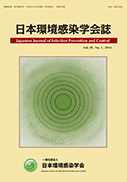Volume 37, Issue 4
Displaying 1-7 of 7 articles from this issue
- |<
- <
- 1
- >
- >|
proceedings
-
2022 Volume 37 Issue 4 Pages 115-118
Published: July 25, 2022
Released on J-STAGE: January 25, 2023
Download PDF (281K)
Original Article
-
2022 Volume 37 Issue 4 Pages 119-127
Published: July 25, 2022
Released on J-STAGE: January 25, 2023
Download PDF (414K) -
2022 Volume 37 Issue 4 Pages 128-135
Published: July 25, 2022
Released on J-STAGE: January 25, 2023
Download PDF (722K)
Short Paper
-
2022 Volume 37 Issue 4 Pages 136-138
Published: July 25, 2022
Released on J-STAGE: January 25, 2023
Download PDF (421K) -
2022 Volume 37 Issue 4 Pages 139-142
Published: July 25, 2022
Released on J-STAGE: January 25, 2023
Download PDF (366K)
Report
-
2022 Volume 37 Issue 4 Pages 143-147
Published: July 25, 2022
Released on J-STAGE: January 25, 2023
Download PDF (430K) -
2022 Volume 37 Issue 4 Pages 148-154
Published: July 25, 2022
Released on J-STAGE: January 25, 2023
Download PDF (786K)
- |<
- <
- 1
- >
- >|
